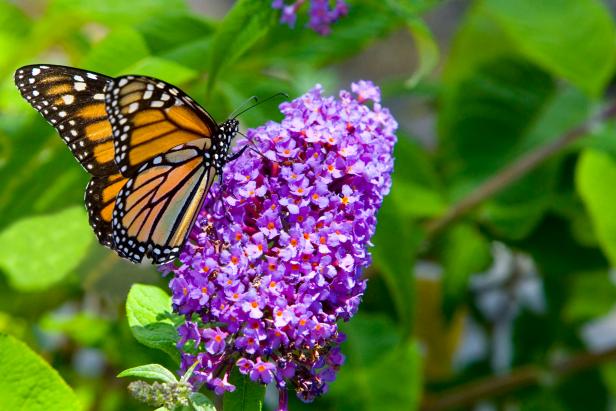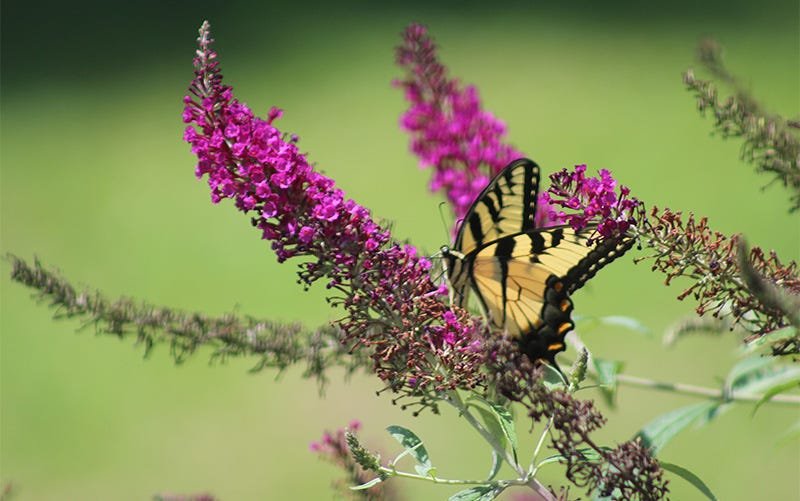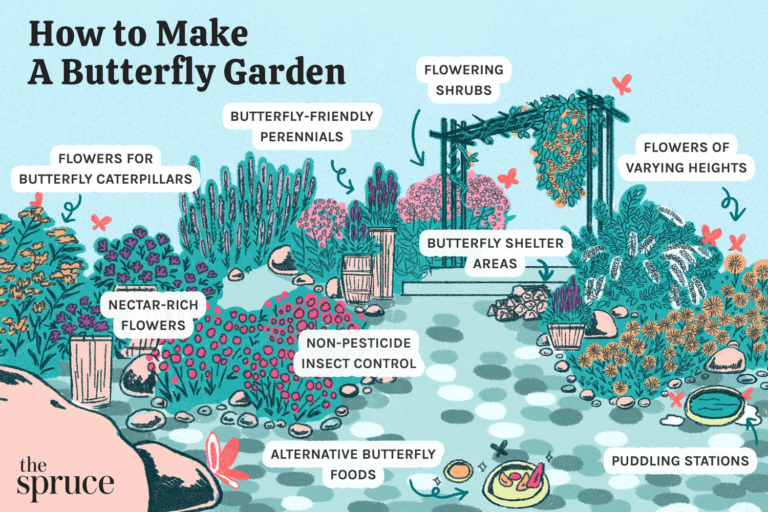Creating a butterfly garden transforms your space into a vibrant sanctuary. Choosing the right plants is essential.
Imagine your garden alive with colorful butterflies, fluttering from flower to flower in a delicate dance of nature. Nectar plants are the lifeblood of a successful butterfly garden, providing vital sustenance for these winged beauties. To attract a diverse array of butterflies, your garden should offer a banquet of blooms that cater to their tastes throughout the seasons.
This doesn’t just benefit the butterflies; you also get a front-row seat to one of nature’s most enchanting displays. The best nectar plants for your butterfly garden are those that bloom abundantly, are rich in nectar, and easy to maintain. This post will guide you through selecting plants that not only thrive in your garden but also turn it into a butterfly paradise. Whether you have a green thumb or are new to gardening, you can create a haven for butterflies with the right information and a touch of care.
Attracting Butterflies: The Importance Of Nectar Plants
Attracting butterflies to your garden isn’t just about the beauty they bring. It’s about creating a space where these delicate creatures can thrive. Nectar plants play a crucial role in this. They provide essential food for butterflies. Without nectar, these flying jewels couldn’t survive.
Why Nectar Is Vital For Butterflies
Butterflies need nectar to live. It’s like energy for them. Nectar gives them the power to fly and mate. Without it, they can’t do what they need to do to survive.
- Energy Source: Nectar is rich in sugars. This gives butterflies energy.
- Survival: Without nectar, butterflies can’t live long.
- Reproduction: Nectar fuels butterflies to mate and lay eggs.
The Role Of Nectar Plants In Butterfly Gardens
Nectar plants are not just food spots for butterflies. They are the heart of a butterfly garden. The right plants attract more butterflies. This creates a healthy garden environment.
| Nectar Plant | Butterfly Species Attracted |
|---|---|
| Milkweed | Monarch |
| Coneflower | Swallowtail |
| Zinnia | Painted Lady |
Choose plants with different colors and shapes. This will bring different butterfly types. Place your nectar plants in sunny spots. Butterflies love the sun. Also, plant in groups. This helps butterflies find the flowers easier.

Top Nectar Plants For Butterfly Gardens
Creating a butterfly garden brings life and color to your yard. Butterflies add beauty and help pollinate flowers. Nectar plants are key to attract these flying jewels. Let’s explore the best picks for your garden.
Milkweed: The Monarch Butterfly Favorite
Monarch butterflies need milkweed. It’s their only caterpillar food plant. Plant different types of milkweed. This will help monarchs all season. Here are top milkweed options:
- Common Milkweed – great for sunny spots
- Swamp Milkweed – loves wet soil
- Butterfly Weed – bright orange flowers
Coneflowers: A Pollinator’s Paradise
Coneflowers are a pollinator magnet. They provide nectar for many butterflies. Their large, colorful blooms stand out. Plus, they are easy to grow. Look at these popular coneflower types:
| Type | Color | Height |
|---|---|---|
| Purple Coneflower | Pinkish-purple | 3-4 ft |
| White Swan Coneflower | Creamy white | 2-3 ft |
Selecting The Right Plants For Your Region
Creating a butterfly garden is exciting. A key step is selecting the right plants for your region. This ensures your garden thrives and attracts many butterflies. Let’s explore how to pick these plants.
Understanding Regional Plant Hardiness
Plant hardiness is crucial. It tells you what plants survive in your area. Each region has a hardiness zone. This zone guides you in choosing plants that can withstand local weather.
- Find your hardiness zone online.
- Choose plants suited for your zone.
Local Nectar Plants For Local Butterfly Species
Different butterflies like different plants. Selecting local nectar plants attracts local butterflies. Here are steps to pick these plants:
- Research local butterfly species.
- Find out what plants they prefer.
- Pick plants that match your hardiness zone.
By following these steps, your butterfly garden will be a success. It will be full of life and color. Happy gardening!

Designing Your Butterfly Garden
Imagine a garden alive with vibrant butterflies. To attract these winged beauties, a well-designed butterfly garden is crucial. Let’s dive into the essentials for creating a fluttering haven.
Creating A Layout For Plant Varieties
Strategic placement of plants leads to a thriving butterfly garden. The layout should include host plants for caterpillars and nectar-rich flowers for adult butterflies. Consider the following:
- Sun exposure – Butterflies love sunny spots. Choose areas that receive at least six hours of sunlight daily.
- Shelter – Protect your garden from strong winds. Use shrubs or tall plants as natural windbreaks.
- Accessibility – Group plants closely to help butterflies conserve energy while feeding.
Include a variety of plants to ensure continuous blooms throughout the seasons. This supports a steady food supply for visitors.
Color Schemes And Bloom Times
Butterflies are drawn to bright colors and sustained blooms. Mixing colors and coordinating bloom times can maximize your garden’s appeal. Here’s how:
| Color | Plant Example | Bloom Time |
|---|---|---|
| Yellow | Black-eyed Susan | Summer |
| Purple | Lavender | Spring-Summer |
| Red | Bee Balm | Summer |
| Orange | Butterfly Weed | Summer |
Plan for staggered blooming to provide nectar from spring to fall. This approach keeps butterflies coming back for more.
Planting For Continuous Blooms
Creating a butterfly garden requires planning for blooms that last all season. This ensures butterflies enjoy a steady supply of nectar. Let’s discuss how to achieve a garden that flourishes and feeds butterflies from spring to fall.
Sequential Blooming: Ensuring Season-long Nectar
Seasonal planning is key for continuous blooms. Start with early bloomers like crocuses and move to late bloomers like asters. Here’s a simple guide:
- Spring: Plant lilacs and snapdragons.
- Summer: Include coneflowers and lavender.
- Fall: Rely on sedum and goldenrod.
These plants bloom one after another, offering nectar through the seasons.
Mixing Annuals And Perennials For Sustained Flowering
Combine annuals and perennials for long-lasting blooms. Annuals bloom all season, while perennials return yearly. Consider these options:
| Annuals | Perennials |
|---|---|
| Marigolds | Salvia |
| Zinnias | Phlox |
| Petunias | Joe-Pye Weed |
With this mix, your garden stays vibrant and full of life. Butterflies will thank you!
Caring For Your Nectar Plants
Caring for Your Nectar Plants is crucial for a thriving butterfly garden. These plants need the right mix of water, nutrients, and protection from pests. Let’s dive into how to keep them in top condition.
Watering And Fertilizing For Optimal Growth
Regular watering keeps plants healthy. Aim for early morning. This reduces water loss and helps plants absorb more. Use a drip irrigation system for best results. It ensures deep watering.
Fertilizing is next. It boosts plant growth. Use a balanced fertilizer. Apply it in spring and mid-summer. Always follow the package instructions.
Pest Control: Keeping Your Plants Healthy
Pests can harm your nectar plants. Regular checks are vital. Look for signs of damage. Use organic pesticides when needed. They are safe for butterflies. Removing dead leaves also helps prevent pests. Keep your garden clean.
- Water early in the morning.
- Use a drip irrigation system.
- Apply balanced fertilizer twice a year.
- Check plants for pests regularly.
- Use organic pesticides.
- Remove dead leaves to keep the area clean.
Beyond Nectar: Other Butterfly Garden Essentials
Creating a butterfly garden goes beyond just offering nectar. It’s about providing a habitat that caters to all life stages of butterflies. From the caterpillar to the majestic winged adult, each phase requires different resources. Let’s explore some essentials to make your garden a butterfly paradise.
Host Plants For Caterpillars
Host plants are vital for butterfly gardens. These are where butterflies lay their eggs. Caterpillars feed on these plants after hatching. Include a variety of host plants to attract different butterfly species.
- Milkweed for Monarchs
- Parsley and dill for Swallowtails
- Willow and cherry for Mourning Cloaks
Providing Shelter And Water Sources
Butterflies need shelter from predators and harsh weather. Dense shrubs and tall grasses offer good cover. A water source is also key for hydration and minerals. Create shallow puddles or a sand-water mix in a dish for them to sip from.
| Shelter Type | Benefits |
|---|---|
| Dense Shrubs | Protection from wind and predators |
| Tall Grasses | Safe spots for resting |
| Water Features | Hydration and minerals |
Observing And Enjoying Your Butterfly Garden
Observing and Enjoying Your Butterfly Garden turns your landscape into a live canvas. Colorful butterflies flit from bloom to bloom in a dance of joy. The garden becomes more than just a visual treat; it’s a hub of activity. Now, let’s delve into making the most of this experience.
Best Practices For Butterfly Watching
- Stay still to avoid startling them
- Wear muted colors that blend with the garden
- Visit during warm, sunny days for peak activity
- Use binoculars for close-up views without intrusion
Photographing Butterflies: Tips And Tricks
Photographing butterflies requires patience and skill. Use these tips for stunning images:
- Set your camera to a fast shutter speed
- Choose a low ISO to reduce grain
- Wait for butterflies to land for clear shots
- Focus on eyes for a connection in the photo

Frequently Asked Questions
What Are The Top Nectar Plants For Butterflies?
Butterflies are attracted to a variety of nectar plants, but some of the top choices include Milkweed, Purple Coneflower, and Butterfly Bush. These plants not only provide essential nutrients but also support butterfly populations by offering safe breeding grounds.
How Often Should You Water Butterfly Garden Plants?
Watering frequency for butterfly garden plants varies, but generally, they require watering once a week. During hotter, drier periods, more frequent watering may be necessary to keep the soil moist but not waterlogged, ensuring optimal growth and nectar production.
Can Butterfly Gardens Attract Other Wildlife?
Yes, butterfly gardens can attract other wildlife such as bees, birds, and beneficial insects. The diverse plant selection and the nectar-rich flowers create a welcoming environment for various species, promoting a healthy and biodiverse ecosystem in your garden.
What Are Easy-care Nectar Plants For Beginners?
For beginners, some easy-care nectar plants include Zinnias, Marigolds, and Lavender. These plants are not only straightforward to grow but also resilient, requiring minimal maintenance while providing a vibrant and attractive habitat for butterflies.
Conclusion
Creating a butterfly garden brings nature’s best to your backyard. Include these top nectar plants for a vibrant display. Butterflies will flock to your garden, giving life to your outdoor space. Start simple, choose a variety of plants, and watch your garden become a butterfly haven.
Embrace the joy of gardening and the beauty of butterflies together. Your new butterfly friends await!


